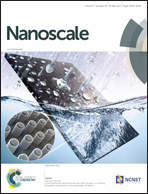Non-volatile iron carbonyls as versatile precursors for the synthesis of iron-containing nanoparticles†
Abstract
The most commonly used method for the formation of well-defined iron and iron-containing heterometallic nanoparticles is the thermal decomposition of iron pentacarbonyl (Fe(CO)5). However, iron pentacarbonyl is highly toxic and volatile, which introduces safety concerns and drastically diminishes control over the reaction stoichiometry. Here we alleviate these issues by beginning with an easy-to-handle solid, triiron dodecacarbonyl (Fe3(CO)12). The issue of poor solubility of this cluster is addressed by its reaction with amine, which renders the cluster fully soluble in common high boiling point solvents. This reaction generates non-volatile anionic iron carbonyl species in solution which are subsequently used as the nanoparticle precursor. We demonstrate that the thermolysis of this novel precursor solution yields well-defined Fe, Fe1−xCox, and Fe1−xPtx nanoparticles. In addition, the same approach overcomes the solubility issue of another poorly soluble iron carbonyl compound, diiron nonacarbonyl (Fe2(CO)9). By using these precursors in an array of nanoparticle-forming reactions, we demonstrate a convenient replacement for the commonly used Fe(CO)5, producing particles of similar quality, but without the drawbacks of the precursor volatility and high toxicity.


 Please wait while we load your content...
Please wait while we load your content...